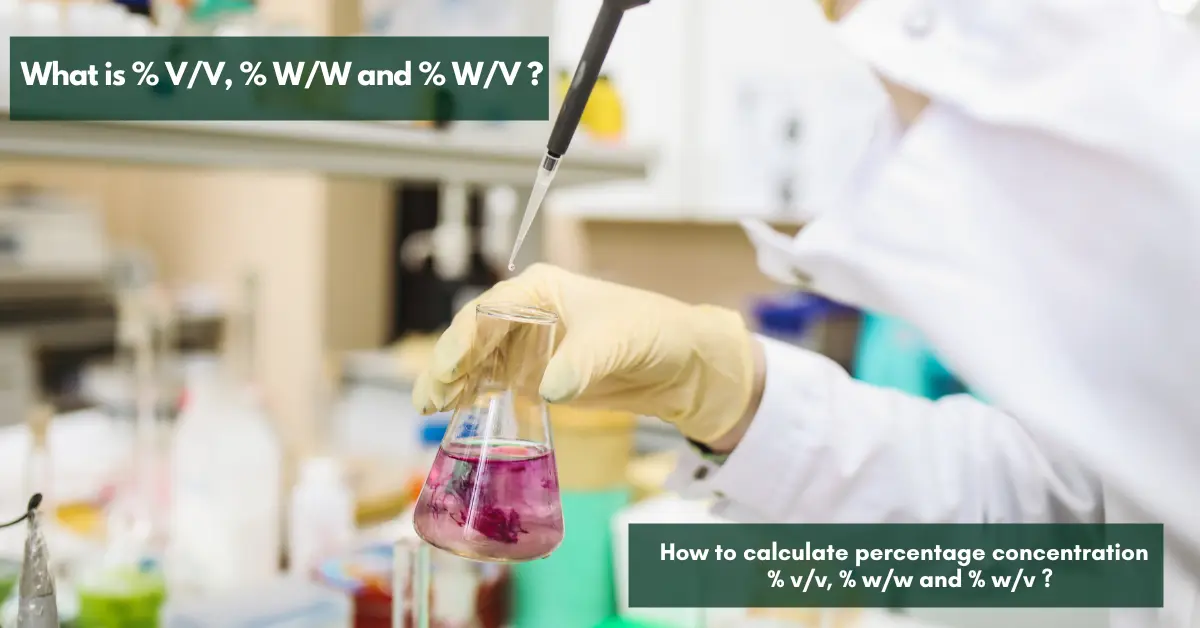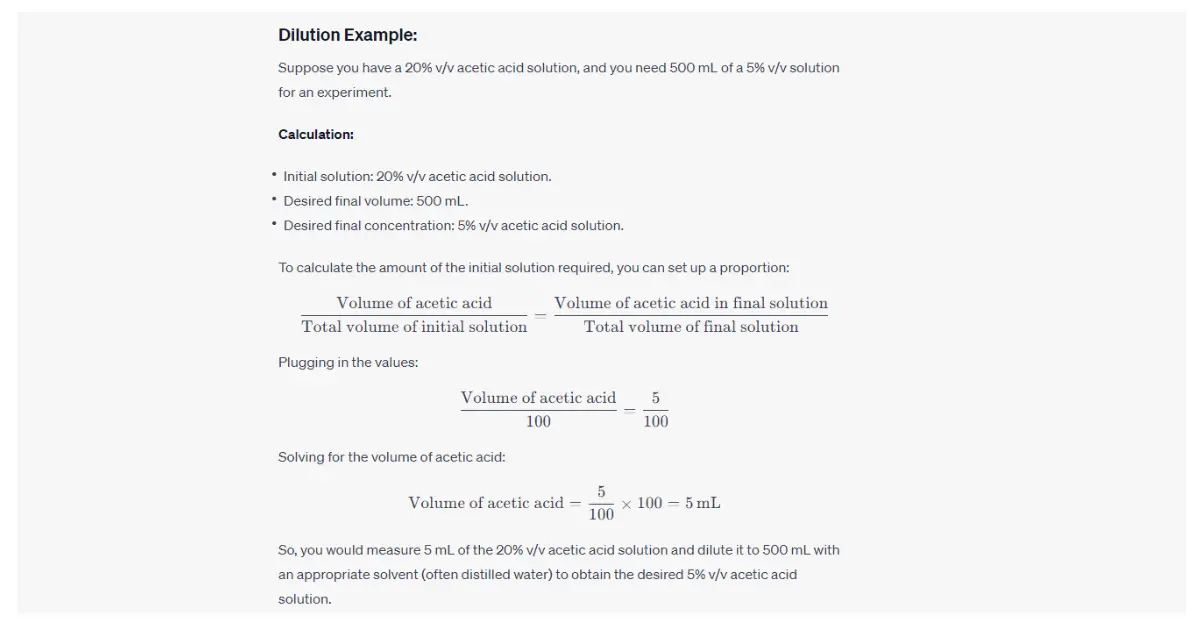The concept of making solution in % v/v, % w/w, and % w/v are used in various industries including pharmaceuticals, chemistry, food and beverages, and many others.

In the quality control (QC) laboratories precision and accuracy are of very importance measure. One of the critical task of laboratory work is understanding and correctly making different types of percent concentrations. the most frequently used percent concentrations in QC are % v/v, % w/w, and % w/v.
In this article, we will delve into the definitions, examples, and calculations related to these percent concentration units.
What is % v/v, % w/w, and % w/v?
Percent concentration is a way of expressing the relative amount of a solute (substance being dissolved) in a solution (mixture of solute and solvent).
The three commonly used types are:
% v/v (percent volume/volume)
The volume concentration is expressed as % v/v, which stands for volume per volume. This refers to the volume of solute present in 100 volumes of the solution. It is used when both the solute and solvent are liquids and have a similar density. % v/v is commonly used in the pharmaceutical and beverage industries for solutions, syrups, and tinctures.
For example, when 10 ml of sulphuric acid is diluted with 90 ml of water, there will be 10 ml of sulphuric acid in a total volume of 100 ml. Therefore, we would express the concentration of this solution as sulphuric acid 10% v/v.
% w/w (percent weight/weight)
The weight concentration of a solution is expressed as % w/w. This indicates the weight of the solute in 100 units of the solution. It is used when both the solute and solvent are solid substances. % w/w is prevalent in the food industry for dry mixes, powders, and solid formulations.
For example, if the total mass of a 100 g solution is made up of 50 g hydrochloric acid in 50 g of water, then we would express this as hydrochloric acid 50 % w/w.
% w/v (percent weight/volume)
The mass concentration of a solution is expressed as % w/v for weight per volume. This represents the weight of the solute in 100 units of the solution’s volume. It is commonly used when a solid solute is dissolved in a liquid solvent. % w/v is frequently encountered in laboratories working with reagents and solutions, such as titrations and dilutions.
It can alternatively be abbreviated to m/v for mass per volume.
For example, If 5 g of potassium iodide is used to make up a total volume of 100 ml, then a 5 % w/v solution of potassium iodide has been made.
what are the Examples of % v/v, % w/w, and % w/v?
% v/v
Imagine you are in a QC lab at a pharmaceutical company tasked with creating a 5% v/v ethanol solution for a mouthwash product. This means that 5 volumes of ethanol are present in 100 volumes of the mouthwash solution.
Calculation:
- If you need 500 mL of the 5% v/v ethanol solution, 5% of it should be ethanol.
- 5% of 500 mL = 0.05 * 500 mL = 25 mL.
- So, you would measure 25 mL of ethanol and add it to 475 mL of the mouthwash solution.
% w/w
Consider a scenario in the food industry where you’re preparing a spice blend with a desired 10% w/w salt content. This means that 10 parts of salt are present in every 100 parts of the spice blend.
Calculation:
- If you need 1 kg of the spice blend, 10% of it should be salt.
- 10% of 1 kg = 0.10 * 1 kg = 100 g.
- Therefore, you would mix 100 g of salt with 900 g of other spices to achieve the desired blend.
% w/v
In a laboratory setting, you might be required to create a 2% w/v sodium hydroxide (NaOH) solution for a chemical reaction. This implies that 2 grams of NaOH are dissolved in 100 mL of the solution.
Calculation:
- If you need 250 mL of the 2% w/v NaOH solution, 2% of it should be NaOH.
- 2% of 250 mL = 0.02 * 250 mL = 5 g.
- You would dissolve 5 g of NaOH in enough solvent to make a final volume of 250 mL.
Importance of Accurate Calculations in QC
In QC laboratories, precision is a very first priority. A slight miscalculation in percent concentrations can directly impact products quality, erroneous results, or even safety hazards. It’s crucial to understand the distinctions between % v/v, % w/w, and % w/v and apply them correctly to ensure the reliability and consistency of your work.
Calculating Dilutions and Concentrations
One common task in QC labs is preparing dilutions of concentrated solutions to achieve specific concentrations. Understanding percent concentrations helps in making accurate dilutions. Let’s explore a dilution example using % v/v:
Dilution Example:

Conclusion
While working in quality control laboratories, precision, accuracy, and meticulous calculations are essential part of routine activity. Percent concentrations % v/v, % w/w, and % w/v serve as fundamental tools for expressing the relative amounts of solutes and solvents in solutions. The application of Percent concentrations in a wide range of industries, from pharmaceuticals to food and chemistry.
Understanding the concepts behind these percent concentrations empowers laboratory professionals to create precise solutions, perform accurate analyses. It improves the overall quality and safety of products and processes. Whether you’re measuring ingredients or conducting complex experiments, a percent concentrations is a necessary skill in the quality control Lab.
FAQ
What does W by V mean?
WV mean that how many gram of API/solute per 100 mL of the solution. for example the label indicate that the medication contains 10% (w/v) paracetamol where (w/v) is weight per 100 ml volume.
What does 70% VV mean?
70% VV mean for every 100 mL of solution, there are 70 mL of the solute. 70 % isopropanol means in 100 ml total solution contain 70 ml isopropanol.
What do you mean by 95% ethanol?
It also called the rectified spirit. it is the highly concentrated form of ethanol that contains 95% ethanol and 5% water by weight.
Example
% v/v 70% ipa. 70 ml ipa and 100 ml water solution
% w/v. Sugar solution 10 g sugar 90 ml water called 10%w/v sugar solution
% w/w. 50 g hcl and 50 g water solution called 50% w/w hcl solution